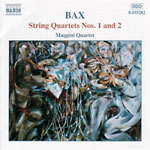Arnold Bax’s chamber music has been largely overshadowed today by his newly popular orchestral works, and in some instances, such as the first of his eminently fine string quartets, all but forgotten. Quartet No. 1 draws deeply on the grand quartet heritage of the 19th century, most notably Dvorák, whose Quartet No. 11 sounds to have been a model for Bax, so similar are their opening themes (not to mention Bax’s use of a pentatonic scale in the secondary material). The central slow movement prefigures Bax’s later luxuriantly atmospheric style with its languorous main theme supported by his trademark descending chromatic counterpoint. The finale, a self-styled jig on a popular Irish tune, brings the work to an upbeat and bright conclusion.
Quartet No. 2 is a tougher nut, and thus did not achieve the initial popularity of its predecessor. The opening movement’s angular contortions give way to secondary material of a more lyrical stripe; however, it’s not until the second movement that you find the expected Baxian lushness–and even here you can’t get too comfortable, for sharp edges lurk in the shadows. A determined optimism characterizes the hard-dancing finale, which features two fugato passages before ending in a brilliant coda. Both quartets are important contributions to the repertoire, something made abundantly clear by the Maggini Quartet’s masterful, deeply felt, and finely executed readings. The ensemble’s burning conviction will make you a believer too, especially in this beautifully engineered production from Naxos.
































